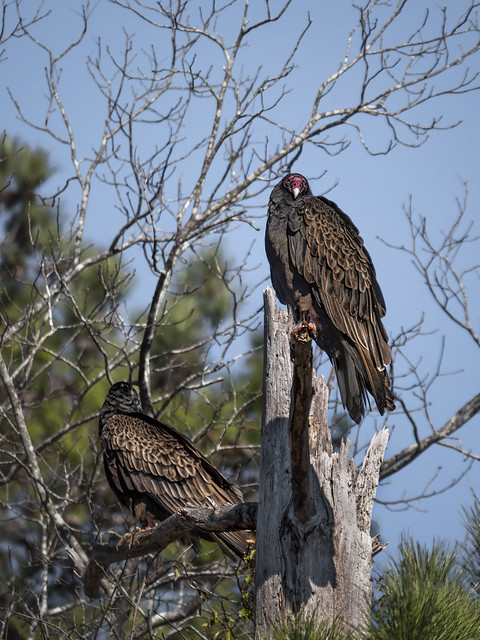Saturday, February 04, 2023
Pic(k) of the Week: Arabia buzzards
A pair of turkey vultures scope the carrion scene, atop a pine tree near the summit of Arabia Mountain.The turkey vulture (Cathartes aura), also known as buzzard or turkey buzzard, is the most widespread of the New World vultures, ranging from southern Canada to the southernmost tip of South America. It inhabits a variety of open and semi-open areas, including subtropical forests, shrublands, pastures, and deserts. A large bird, the turkey vulture has a wingspan of 63-72 inches (160–183 cm) and a length of 24-32 inches (62–81 cm). The body feathers are mostly brownish-black, but the flight feathers on the wings appear to be silvery-gray beneath, contrasting with the darker wing linings. The adult's head is small in proportion to its body and is red in color with few to no feathers. It also has a relatively short, hooked, ivory-colored beak. The turkey vulture is a scavenger and feeds almost exclusively on carrion. It has very few natural predators.— Wikipedia.
Arabia Mountain National Heritage Area: Stonecrest, Georgia, USA. 27 January 2023.
-----more-----
- "National Heritage Areas are places where historic, cultural, and natural resources combine to form cohesive, nationally important landscapes. Unlike national parks, National Heritage Areas are large lived-in landscapes. Consequently, National Heritage Area entities collaborate with communities to determine how to make heritage relevant to local interests and needs. In 1984, the first National Heritage Area, Illinois and Michigan Canal National Heritage Area, was signed into law by President Ronald Reagan. As of 2023, sixty-two National Heritage Areas are designated."
— National Park Service. - "National Heritage Areas are NOT National Park Service units or federally owned or managed land. NHAs are administered by state governments or non-profit organizations or other private corporations, referred to as local coordinating entities. The National Park Service provides an advisory role and limited technical, planning and financial assistance. Each area has its own authorizing legislation and a set of unique resources and goals. Areas considered for designation must have specific elements. First, the landscape must be a nationally unique natural, cultural, historic, or scenic resource. Second, when the related sites are linked, they must tell a unique story about the U.S."
— Wikipedia. - Pic(k) of the Week: one in a weekly series of images posted on Saturdays, occasionally, but not always (as is the case today), with a good fermentable as the subject.
- Photo 6 of 52, for year 2023. See a hi-res version at Flickr: here.
- Commercial reproduction requires explicit permission, as per Creative Commons.
- Camera: Olympus OM-D E-M10 II.
- Lens: Lumix G Vario 100-300/F4.0-5.6
- Settings: 300 mm | 1/1250 sec | ISO 200 | ƒ/5.6
-
For more from YFGF:
- Follow on Facebook: YoursForGoodFermentables.
- Follow on Flickr: Cizauskas.
- Follow on Instagram: @tcizauskas.
- Follow on Vero: @cizauskas.
at
7:27 AM
![]()
![]()
Labels: bird, Georgia, National Heritage Area, nature, park wildlife, Pic(k) of the Week, southeastern US
Subscribe to:
Post Comments (Atom)










No comments:
Post a Comment
Comment here ...